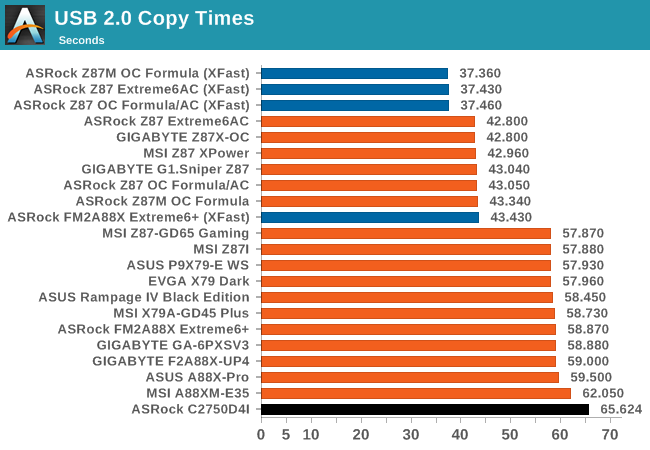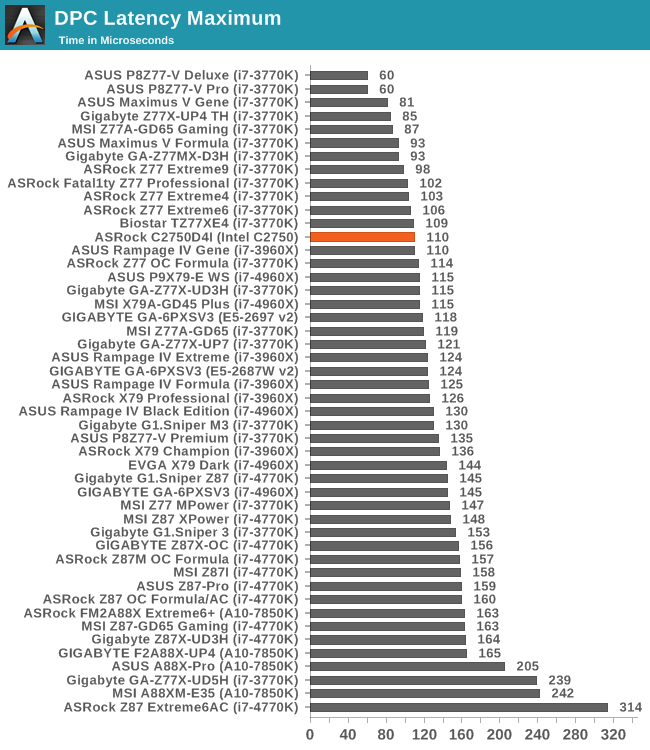ASRock Rack C2750D4I Review: A Storage Motherboard with Management
by Ian Cutress on April 29, 2014 9:00 AM EST- Posted in
- Motherboards
- Storage
- Atom
- ASRock
- Silvermont
- Enterprise
- server
- Avoton
System Benchmarks
USB Backup
For this benchmark, we run CrystalDiskMark to determine the ideal sequential read and write speeds for the USB port using our 240 GB OCZ Vertex3 SSD with a SATA 6 Gbps to USB 3.0 converter. Then we transfer a set size of files from the SSD to the USB drive using DiskBench, which monitors the time taken to transfer. The files transferred are a 1.52 GB set of 2867 files across 320 folders – 95% of these files are small typical website files, and the rest (90% of the size) are the videos used in the WinRAR test. In an update to pre-Z87 testing, we also run MaxCPU to load up one of the threads during the test which improves general performance up to 15% by causing all the internal pathways to run at full speed.

USB effectiveness is often limited by how quickly a system can turn on all the pathways for the required data, as well as the underlying chipset implementation. Avoton is not going to win any records today for USB speed, and the lack of a USB 3.0 port is an oversight.
DPC Latency
Deferred Procedure Call latency is a way in which Windows handles interrupt servicing. In order to wait for a processor to acknowledge the request, the system will queue all interrupt requests by priority. Critical interrupts will be handled as soon as possible, whereas lesser priority requests, such as audio, will be further down the line. So if the audio device requires data, it will have to wait until the request is processed before the buffer is filled. If the device drivers of higher priority components in a system are poorly implemented, this can cause delays in request scheduling and process time, resulting in an empty audio buffer – this leads to characteristic audible pauses, pops and clicks. Having a bigger buffer and correctly implemented system drivers obviously helps in this regard. The DPC latency checker measures how much time is processing DPCs from driver invocation – the lower the value will result in better audio transfer at smaller buffer sizes. Results are measured in microseconds and taken as the peak latency while cycling through a series of short HD videos - less than 500 microseconds usually gets the green light, but the lower the better.

While the system is not a digital audio workstation target, as our DPC test is quick and painless the results are included for completeness. The system actually does rather well, right in the middle of our Z77 testing.










85 Comments
View All Comments
A5 - Tuesday, April 29, 2014 - link
For HTPC, I'd think you would probably want to get a small GPU for decode help anyway, so that would be where your audio comes from as well.bernstein - Tuesday, April 29, 2014 - link
yeah it's a shame this doesn't come with a hdmi connector... then i'd be sold. even though i wouldn't use any of the sata plugs and just hook a sas controller+expander up to it...hdmi + ecc + pcie x8 capability cpu+mobo for $400 would be a steal
slayernine - Tuesday, April 29, 2014 - link
QNAP's Intel Atom models have HDMI.bernstein - Tuesday, April 29, 2014 - link
yeah if only they had fanless 10+ bay models for less than $1000.bernstein - Tuesday, April 29, 2014 - link
oh and one that runs zfsGralgrathor - Thursday, May 21, 2015 - link
10+ disks without cooling? They won't last a day... And why would you need a hdmi-connector on a server mobo?DanNeely - Tuesday, April 29, 2014 - link
At $400 it's priced out of the core HTPC market; it's clearly intended as an entry level large storage server. As pointed out below, the spaghetti explosion from wiring a dozen drives with individual cables makes it unsuitable for most enterprise use (or prosumers who know better).Samus - Wednesday, April 30, 2014 - link
For $400 you could put together a better HTPC/NAS combo solution with an AMD AM1 ITX system and an Areca SAS RAID card in a PCIe slot. You'd get a superior onboard GPU with HDMI, native USB 3.0, and a better RAID card, not some Marvell crap.Athlon 5350 http://www.newegg.com/Product/Product.aspx?Item=N8...
ASUS AM1 ITX http://www.newegg.com/Product/Product.aspx?Item=N8...
Areca PCIe 8-port SAS http://www.newegg.com/Product/Product.aspx?Item=N8...
This motherboard is interesting and ASRock is a solid consumer OEM, but it's a little premature of them to be getting into rack space.
UpSpin - Wednesday, April 30, 2014 - link
You don't have to buy the overpriced octa core board, but could buy the identical quad core version ASRock C2550D4I for $280.http://www.newegg.com/Product/Product.aspx?Item=N8...
Your mainboard doesn't support ECC RAM and your SAS Controller only supports 8 SATA drives without further expanders. Together with the two SATA connectors on the mainboard you got only 10.
The quad core has an even lower TDP of 14W vs. 20W of the octa version. The C2750 has a faster CPU compared to your Athlon 5350.
The only disadvantage is the poor IGP. Considering that this is more a storage/server board, less a HTPC (who wants 12 noisy hard drives in the living room?) and the unbeatable price, it's a very interesting porduct in my opinion.
Samus - Friday, May 2, 2014 - link
Well, UpSpin, that would be why I said 'htpc/nas'If you purely want a NAS, there are probably better solutions than what I outlined, but for a hybrid (and who is to say the NAS wont be SSD's or 2.5" 2TB drives that are dead silent) this board, like Ian pointed out, is kind of a joke for an HTPC solution. It is VERY market specific, and virtually ALL AT readers aren't part of that market. This board is grossly overpriced, especially for something with ASRocks name on it. Even cold-storage servers should have USB 3.0 or eSATA. and quality products don't use some buggy $3.00 Marvell chipset that wipes arrays at random.